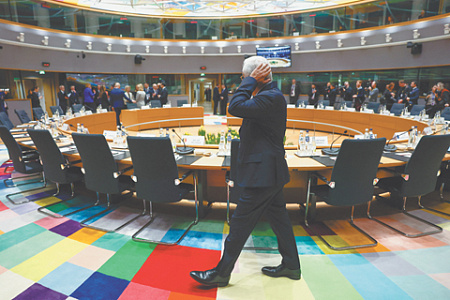
Strengthening the EU’s defense and the conflict in Ukraine in the context of US President Donald Trump’s attempts to force Kiev into an “unfair peace” and “capitulation to Russia” became the main topics of an emergency EU summit in Brussels on Thursday. As part of the largest security initiative in Europe since the Cold War, the EU intends to allocate hundreds of billions of euros in additional military funding.
The summit in Brussels was called fateful in advance, and the situation in Europe due to the actions of the Russian Federation and the decision of the US administration to suspend military assistance to Ukraine is even more threatening than three years ago. “Europe is facing a clear and real danger on a scale that none of us have seen in our adult lives,” said European Commission President Ursula von der Leyen.
In the current situation, Europe must enter the arms race and win it, Polish Prime Minister Donald Tusk said upon arrival in Brussels. According to him, initiatives to increase funding for the EU defense industry represent the first step on this path.
President of Ukraine Volodymyr Zelensky was invited to the European summit. After his speech, he left the meeting room, and the leaders of the 27 countries began discussing the agenda of the meeting. As Euroaktiv reported on the eve of the summit, it was decided to put the issue of support for Ukraine, which is splitting the European Union and complicating relations with the United States, on the back burner. The proposal of the EU High Representative for Foreign Affairs and Security Policy, Kai Kallas, to allocate a $20 billion aid package to Kiev was excluded from the draft final statement. Hungary blocked this initiative.
At the same time, according to the Finnish news agency STT, which reviewed the draft statement, it could not but declare Brussels’ intentions to continue supporting Ukraine and express approval of the readiness of many member states to increase supplies of ammunition, air defense systems and interceptor missiles to Kiev. In addition, the draft notes that any potential peace agreement should provide reliable security guarantees for Ukraine. Although more detailed discussions on this topic will continue at the EU summit, which will be held on March 19.
Von der Leyen’s ambitious plan to “Rearm Europe” with a budget of 800 billion euros, presented on March 4, became a priority topic of discussion (see NG dated March 4, 25). She clarified to the leaders the details of her proposal regarding the borrowing by EU countries of up to 150 billion euros for defense needs. The European Commission will borrow this money on the global capital markets, and then lend it to the EU countries on the condition that they jointly purchase weapons in Europe. These funds will be used for the production of air defense systems in the EU and weapons for Ukraine.
Von der Leyen also called on the summit participants to increase current defense spending by 1.5% in order to raise 650 billion euros for weapons production. Apparently, they supported the European Commission’s plan, but demanded
To explain in detail the situation with new sources of financing for military needs at the EU level.
Germany has become a kind of pioneer in this issue with the idea of reforming EU budget regulations. This is an initiative by the likely future Chancellor of Germany, Friedrich Merz, head of the Christian Democratic Union, to remove obstacles to increasing military spending and to review the rules of borrowing for this purpose. According to Financial Times sources, the positions of Germany and France on issues of “strategic activation and steps such as increasing investments in defense, combining procurement and their deployment on the European industrial base have significantly converged.”
Nevertheless, the European Union fears that it will have to pay for its own defense and weapons for Ukraine as long as Trump is in charge of the White House. This was reported by Politico, citing European diplomats. They also express doubts about von der Leyen’s ability to achieve the implementation of the plan to “rearm Europe.” “Von der Leyen is trying to take the bull by the horns. But will the technocratic structure of the EU follow it?” the diplomats ask.
Thus, the initiative of the European Commission considers the possibility of mobilizing the European Stabilization Mechanism (MES). However, this idea faces legal and political obstacles. After all, Italy, for example, did not ratify the treaty, and its original purpose was not military. In addition, the MES applies only to the eurozone countries, which excludes the rest of the EU, including Poland.
“The following sources are named for financing the militarization of the EU: The lifting of restrictions on borrowing within the community, the reorientation of financial flows from the development of backward regions to defense needs, and the widespread attraction of loans from outside,” said Vladimir Olenchenko, senior researcher at the IMEMO RAS Center for European Studies. – If you look at the list of weapons contained in the von der Leyen plan, it becomes clear even to a layman: it is dominated not by defensive weapons, but by offensive ones. The list does not look like an instrument of deterrence, but a mechanism for potential aggression.”
According to the expert, von der Leyen’s initiative cannot be considered in isolation from the proposals of French President Emmanuel Macron to send a military expeditionary force to Ukraine. The activity of British Prime Minister Keir Starmer on financing Ukraine and attempts to justify the presence of British-French troops at sea and in the air of Ukraine cannot remain on the sidelines. “The actions and proposals of von der Leyen, Macron and Starmer leave a feeling of coordination. However, there is no unity and will among the 27 EU countries, and without this, any plans are unlikely to be feasible,” Olenchenko concluded.
